Table of contents
Red cabbage ( Brassica oleracea convar. capitata var. rubra) is a particularly aromatic relative of white cabbage. In German cuisine, it is very popular when braised sweet and sour and seasoned with apple. Red cabbage can also be prepared raw, and preferably organic, as a red cabbage salad.
Use in the kitchen
Red cabbage (raw) differs from white cabbage mainly in its red color and its mild, sweet taste. Its head is somewhat smaller and firmer. Are red cabbage and blue cabbage the same? The leaf color ranges from reddish to bluish. How does red cabbage stay red when cooked? Adding acidic ingredients (e.g. vinegar, lemon juice, apples) preserves the red color of the cabbage when cooked. Sugar or alkaline ingredients such as baking soda give a more bluish cabbage dish - hence the alternative name blue cabbage.
When preparing red cabbage, your hands will also get undesirable stains, which can be easily removed with a little lemon juice.
Can you eat red cabbage raw? This typical winter vegetable can be eaten raw, steamed, braised, baked or fried. How do you prepare raw red cabbage? For each preparation method, you should first remove the outermost leaves that no longer look fresh, halve or quarter the head and rinse it. Use a sharp knife to cut out the stalk. Then cut or slice the red cabbage into strips that are appropriate for the dish you want.
Red cabbage is eaten raw mainly as a finely chopped salad. We recommend raw red cabbage salads with fruit (e.g. apples, oranges, mandarins, figs) and nuts (e.g. walnuts, hazelnuts, pecans) or preparing it as coleslaw. You can also spice up hummus with (raw) red cabbage - this tastes great as an aperitif with vegetable sticks. Raw red cabbage is also being used more and more to make red cabbage juice and healthy vegetable-fruit smoothies.
Cooked red cabbage is particularly popular as a side dish to autumn and winter dishes, e.g. prepared with apples and alongside vegan goulash, chestnuts and dumplings or spaetzle. It is typical to prepare it with spices such as nutmeg, cloves and bay leaves. Red cabbage can also be used for Asian rice stir-fries (e.g. with basmati rice, kale, carrots, spring onions, tofu and a dash of soy sauce) or red cabbage and potato soups. It can also be prepared in the oven - either as part of a fine casserole or cut into thick slices as baked vegetable steaks. If you like, you can also pickle and ferment it - it tastes particularly good as kimchi. In addition to the classic spices mentioned above, exotic and oriental spices (e.g. ginger, coriander, curry, cinnamon) also go excellently with red cabbage dishes.
Vegan recipe for raw red cabbage salad
Ingredients (for 4 people): ½ head of red cabbage (approx. 500 g, raw, organic), 2 oranges (organic), 1 red onion, 3 figs (dried), 50 g walnuts, 4 tbsp red wine vinegar, 2 tbsp rapeseed oil, 2 tbsp walnut oil, 2 tsp mustard, ½ bunch of parsley, some salt andpepper.
Preparation: Remove the outer leaves of the red cabbage, cut out the stalk and cut the head into thirds lengthways. Cut the thirds into fine strips or slice them and place in a bowl. Add a little salt and knead the cabbage strips for about 5 minutes - this will give them a tender texture. Peel an orange and cut the individual pieces into slices. Peel and dice the onion. Squeeze the juice from the second orange. Puree this together with the dried figs and the red wine vinegar in a tall container using a hand blender. Add the walnut oil, rapeseed oil and mustard, mix everything together and season with salt and pepper. Put the red cabbage strips, orange slices and onion cubes in a bowl, pour the dressing over them and mix the salad well. Roughly chop the walnuts. Rinse the parsley, shake dry and chop finely. Pour both over the vegan red cabbage and orange salad shortly before serving.
Vegan recipes with red cabbage (raw) can be found under the note: " Recipes that have the most of this ingredient ".
| Not only vegans or vegetarians should read this: Vegans often eat unhealthily. Avoidable nutritional errors. |
Purchasing - Storage
Red cabbage (raw) can be bought in all supermarkets (e.g. Coop, Migros, Denner, Volg, Spar, Aldi, Lidl, Rewe, Edeka, Hofer, Billa). The main season for red cabbage is in autumn, so it is available fresh in northern Central European countries from September to November. Because it can be stored well, it can usually be bought in supermarkets all year round, and certainly into summer. If it is not available fresh, you can find it cooked and preserved in jars or bags. Organic supermarkets (e.g. Alnatura, Denn's Biomarkt) also sell red cabbage, fresh and preserved, in organic quality (bio).
Storage tips
How long can you keep red cabbage in the fridge? Fresh red cabbage keeps well in a cool cellar or in the vegetable compartment of the fridge. In the fridge, it is best to wrap it in a damp cloth. This way, it will last up to three weeks as a whole. Once you have cut up red cabbage, you should cover it with foil, preferably reusable wax foil. If stored in the fridge, it will last for around two weeks. You can also freeze the cabbage. To do this, wash it thoroughly, remove the stalk and cut it into strips. Blanch these briefly in boiling salted water, shock them with cold water and then pack them in airtight freezer bags. Red cabbage will last for at least six months in the freezer.
Special storage varieties, e.g. long-life red cabbage, can be kept for up to 8 months under optimal conditions in so-called CA storage facilities. This controlled atmosphere guarantees red cabbage temperatures of 0-0.5 °C, 97% humidity and 4% CO 2 and 3% O 2 during long-term storage. 12
Found in the wild
Wild types of cabbage are differentiated according to the areas in which they occur. The cabbage Brassica oleracea, which is mainly found in Europe, still grows wild in the coastal areas there, one form is also known as Atlantic wild cabbage (Helgoland wild cabbage or cliff cabbage) or Brassica oleracea ssp. oleracea. 10 A very close relative is the wild Brassica cretica, which grows in southern Greece (Aegean Sea). 11
Ingredients - Nutritional values - Calories
Raw red cabbage is very low in calories and almost fat-free, with 31 kcal per 100g and 0.16 g fat per 100g. It also contains little protein (1.4 g/100g). 1
What nutrients are in red cabbage? Raw red cabbage is rich in vitamin C : 57 mg/100g make up 71% of the daily requirement, almost twice as much as in white cabbage (37 mg/100g). Kohlrabi (62 mg/100g) and strawberries (59 mg/100g) contain a similar amount. With 450 mg per 100g, sea buckthorn berries contain particularly high levels of vitamin C. 1
The vitamin K content of red cabbage is 38 µg per 100g (51% of the daily requirement). This is similar to that of celeriac (41 µg/100g). Significantly more vitamin K can be found in chard (830 µg/100g). 1
0.21 mg of vitamin B6 (pyridoxine) is found in 100 g of raw red cabbage (15% of the daily requirement). Savoy cabbage (0.19 mg/100g) and pak choi (0.19 mg/100g) have a similar content. Pistachios contain 1.7 mg of vitamin B6 per 100 g, which is about 8 times the amount. 1
The question often arises as to whether red cabbage contains a lot of iron. At 0.8 mg/100g, it has the same amount as beetroot (raw), which only makes up 6% of the daily requirement. Green leafy vegetables, such as wild garlic (2.9 mg/100g) or spinach (2.7 mg/100g), provide significantly more.
The complete ingredients of red cabbage (raw), the coverage of the daily requirement and comparison values with other ingredients can be found in our nutrient tables. In the article Nutrients explained you will get a detailed insight into the topic.
Effects on health
Is red cabbage healthy? Red cabbage (raw) is rich in vitamins and contains bioactive substances such as anthocyanins, flavonols and glucosinolates, which have a positive effect on health. Anthocyanins are dark plant pigments that color flowers and fruits red to blue and also give red cabbage its color. Their health-promoting effects include antidiabetic, anticancer and cardioprotective. They can also protect us from neurodegenerative diseases and improve eyesight. 2 In addition, anthocyanins act as antioxidants that protect against oxidative damage 2,3 and reduce inflammatory reactions. 4 Fresh, raw red cabbage has the highest antioxidant capacity compared to fermented, stored or steamed red cabbage. 13 Another interesting thing about the anthocyanins from red cabbage is that they are stable over a wider pH value than anthocyanins from blackcurrants. 4
Dangers - Intolerances - Side effects
Eating raw red cabbage can lead to flatulence in people with sensitive stomachs, and this also applies to other types of cabbage. Preparing it with spices such as caraway, fennel seeds or anise can help to make the cabbage more digestible. A cup of tea made from the same spices with the cabbage dish can also have a mitigating effect.
The goitrogens (substances that cause an enlargement of the thyroid gland) contained in red cabbage or cabbage in general can aggravate thyroid problems because they impair the effect of thyroid hormones. Therefore, people who suffer from an underactive thyroid gland are advised to avoid eating raw brassica vegetables. 5 However, it can be assumed that these negative effects only become clinically significant when very large quantities are consumed or when the diet consists exclusively of cabbage, for example. A lack of the trace element iodine also plays a role here.
Folk medicine - natural healing
In traditional Chinese medicine ( TCM), cooked red cabbage is considered to strengthen the stomach, spleen and intestines. It is also said to stimulate blood circulation and thus help with varicose veins, for example.
Ecological footprint - animal welfare
At 0.2 kg CO 2 eq/kg, red cabbage (fresh) has a low CO 2 footprint, similar to that of Brussels sprouts or kohlrabi. 14 The amount of water required to produce 1 kg of cabbage is also significantly lower at 280 liters compared to, for example, eggplant (362 l/kg) or peppers and chilies (379 l/kg). 15 Because of its good storage capacity, red cabbage can be purchased fresh and locally in stores almost all year round; alternatively, red cabbage is also available in jars. However, thanks to the additional processing steps, this product generates more emissions and the CO 2 footprint increases to 0.7 kg CO 2 eq/kg. 14
Red cabbage from organic farming (organic red cabbage) contains fewer nitrates and fewer residues than conventionally grown red cabbage because it does not contain synthetic fertilizers or artificial pesticides, and is therefore preferable for the sake of your own health and the environment. 9
Worldwide occurrence - cultivation
The origin of cabbage is not clearly established. In the literature there are two possible predecessors of cabbage: Brassica montana or Brassica oleracea, with the latter being considered more likely. The place of origin is not entirely clear either, but it is more likely to be in the eastern Mediterranean. 10 Today it is cultivated worldwide.
Cultivation - Harvest
To grow red cabbage, young plants are grown in seed trays with potting soil or in a cold frame. In addition to early cabbage, there are also medium and late ripening red cabbage varieties that differ in the time of sowing. Early cabbage can be sown in a frost-free bed from February to early March, and harvesting begins in May. For summer, autumn and winter cabbage, the seeds are sown directly in the cold frame or bed in March or early April and covered with fleece or foil until around May. Summer cabbage can be harvested between July and September. It is certainly possible to grow red cabbage in a pot on the balcony. It is important to calculate the pot size per head of cabbage with at least 20 cm in diameter and 20 cm deep and to ensure regular watering. Autumn cabbage is harvested from October, winter cabbage until December. It is very important to plant plants at a distance of around 70 cm in the bed, as this is a good way to prevent pests and diseases. A sunny to partially shaded location, sufficient water and deep loamy soil are good conditions for growing red cabbage at home. 7
How does red cabbage grow best? The ideal altitude for growing cabbage is between 700 and 2,200 m above sea level. In places at lower altitudes, cabbage should be grown in the cooler months of the year. Well-drained, sandy loam soils with a high proportion of organic matter and good water retention capacity are important for growing cabbage. The optimal soil pH value is between 6 and 6.5, which influences not only the method of preparation but also the red or blue coloring of the red cabbage. Acidic soils produce a reddish color, alkaline soils a bluish color. The anthocyanins (natural colorants) contained in cabbage trigger the color changes due to their reaction to the acid-base ratio.
For good development, cabbage needs at least 500 mm of rainfall throughout the entire growing season. Cooler temperatures (optimally 16-20 °C) ensure better growth of cabbage. At temperatures above 25 °C, poor head formation is observed. 8
Further information
Red cabbage ( Brassica oleracea convar. capitata var. rubra, also known as Brassica oleracea var. capitata f. rubra) is a cultivated form of the vegetable cabbage ( Brassica oleracea) and a head cabbage, like white cabbage or savoy cabbage. It is closely related to other cabbage varieties, such as kale, kohlrabi, cauliflower, broccoli and Brussels sprouts. Red cabbage heads are relatively firm and have smooth leaves covered with a waxy layer, which are reddish to bluish in color on the outside and inside. 6
Alternative names
Depending on the place of origin, soil pH and method of preparation, red cabbage, red cabbage or red cabbage (in Switzerland, Rotchabis) is also called blue cabbage, blue cabbage, blue cabbage or blue cabbage. The term Kappes is also used for red cabbage.
In English, red cabbage is called red cabbage.
Other applications
The anthocyanins of red cabbage are gaining popularity in the food industry not only as antioxidants but also as natural and stable colorants. 2,3
Bibliography - 15 Sources (Link to the evidence)
| 1. | USDA United States Department of Agriculture. |
| 2. | Wiczkowski W, Szawara-Nowak D, Topolska J. Red cabbage anthocyanins: Profile, isolation, identification, and antioxidant activity. Food Research International. 2013;51(1):303–9. |
| 3. | Ghareaghajlou N, Hallaj-Nezhadi S, Ghasempour Z. Red cabbage anthocyanins: Stability, extraction, biological activities and applications in food systems. Food Chem. 2021;365:130482. |
| 4. | McDougall GJ, Fyffe S, Dobson P, Stewart D. Anthocyanins from red cabbage – stability to simulated gastrointestinal digestion. Phytochemistry. 2007;68(9):1285–94. |
| 5. | Bajaj JK, Salwan P, Salwan S. Various possible toxicants involved in thyroid dysfunction: a review. J Clin Diagn Res. 2016;10(1):FE01–3. |
| 6. | Pflanzen-lexikon Rotkohl (Brassica oleracea var. capitata f. rubra). |
| 7. | Plantura.garden Rotkohl anpflanzen: Experten-Tipps zum Rotkohl-Anbau. |
| 8. | Japan International Cooperation Agency. Cabbage Production. 2009 |
| 9. | Pini U. Das Bio-Food Handbuch. Ullmann Verlag: Potsdam; 2014: 626-627. |
| 10. | Drenckhahn D. Vorkommen des Atlantischen Wildkohls (Brassica oleracea L. subsp. oleracea) an den Kreidefelsen der Ostseeinsel Rügen, Deutschland. Forum Geobotanicum. 2017;7:18-26. |
| 11. | Mabry ME, Turner-Hissong SD, Gallagher EY, McAlvay AC, An H, Edger PP, u. a. The evolutionary history of wild, domesticated, and feral Brassica oleracea (Brassicaceae). Mol Biol Evol. 2021;38(10):4419–34. |
| 12. | Böttcher H. Frischhaltung und Lagerung von Gemüse. Ulmer: Stuttgart. 1996: 147-155. |
| 13. | Wiczkowski W, Szawara-Nowak D, Topolska J. Changes in the content and composition of anthocyanins in red cabbage and its antioxidant capacity during fermentation, storage and stewing. Food Chemistry. Januar 2015;167:115–23. |
| 14. | Reinhardt G, Gärtner S, Wagner T. Ökologische Fussabdrücke von Lebensmitteln und Gerichten in Deutschland. Institut für Energie - und Umweltforschung Heidelberg. 2020. |
| 15. | Mekonnen MM, Hoekstra AY. The green, blue and grey water footprint of crops and derived crop products. Hydrol. Earth Syst. Sci. 2011; 15: 1577-1600. |

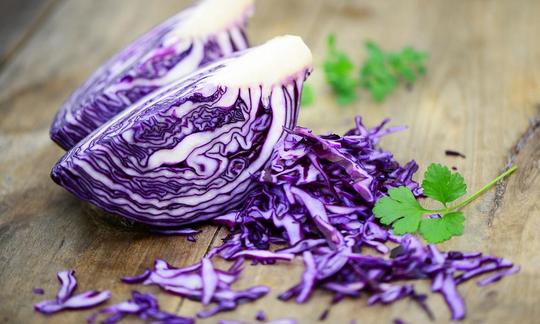

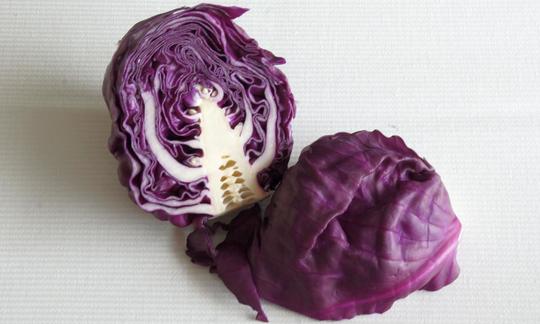

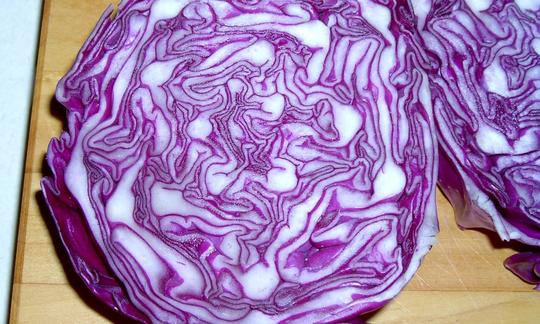

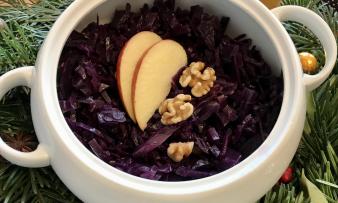
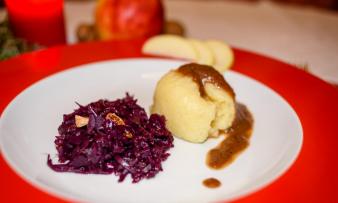
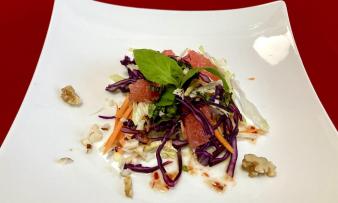


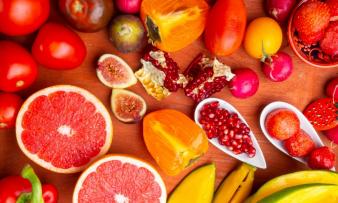


Comments